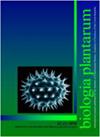HSP70 plays an ambiguous role during viral infections in plants
IF 0.9
4区 生物学
Q4 PLANT SCIENCES
引用次数: 7
Abstract
Heat shock proteins (HSPs) are a family of mainly stressinduced proteins whose primary function is to refold denatured proteins. HSPs are divided into six groups according to their relative molecular mass and primary structure homology (Wang et al. 2004, Park and Seo 2015). The genes that encode HSPs are found in different cell compartments, and HSP expression is controlled by transcriptional factors known as heat shock factors (HSFs) (Haq et al. 2019). In particular, HSP70 is arguably the most conserved protein family among all the organisms, from bacteria to plants and animals. The number of members in different HSP70 families ranges from 18 in Arabidopsis thaliana and 20 in Solanum tuberosum, through 30 in Oryza sativa to 61 in Nicotiana tabacum (Liu et al. 2018, Song et al. 2019). HSP70 are crucial for cells as constitutive and ubiquitously expressed proteins, but HSP70 expression is also induced, not only by heat shock (HS), but by almost all types of plant stresses as well (Park and Seo 2015, Usman et al. 2017). In the classical model for stress activation of HSPs, the presence of stress-induced unfolded proteins in the cell causes the release of HSPs from their constitutive inhibitory association with HSF monomers, although this model could involve more pathways, especially at temperatures that do not unfold proteins. The unfoldedHSP70在植物病毒感染过程中起着模棱两可的作用
热休克蛋白(HSPs)是一个主要由应激诱导的蛋白质家族,其主要功能是使变性蛋白质重折叠。HSP根据其相对分子量和一级结构同源性分为六组(Wang等人,2004,Park和Seo,2015)。编码HSP的基因存在于不同的细胞区室中,HSP的表达由称为热休克因子(HSFs)的转录因子控制(Haq等人,2019)。特别是,HSP70可以说是从细菌到植物和动物的所有生物体中最保守的蛋白质家族。不同HSP70家族的成员数量从拟南芥的18个到茄属的20个,从水稻的30个到烟草的61个不等(Liu等人,2018,Song等人,2019)。HSP70作为组成型和普遍表达的蛋白质对细胞至关重要,但HSP70的表达也受到诱导,不仅是热休克(HS),而且几乎所有类型的植物胁迫也会诱导(Park和Seo 2015,Usman等人2017)。在HSPs应激激活的经典模型中,细胞中应激诱导的未折叠蛋白的存在导致HSPs从其与HSF单体的组成型抑制性结合中释放,尽管该模型可能涉及更多途径,特别是在不展开蛋白的温度下。展开的
本文章由计算机程序翻译,如有差异,请以英文原文为准。
求助全文
约1分钟内获得全文
求助全文
来源期刊

Biologia Plantarum
生物-植物科学
CiteScore
2.80
自引率
0.00%
发文量
28
审稿时长
3.3 months
期刊介绍:
BIOLOGIA PLANTARUM is an international journal for experimental botany. It publishes original scientific papers and brief communications, reviews on specialized topics, and book reviews in plant physiology, plant biochemistry and biophysics, physiological anatomy, ecophysiology, genetics, molecular biology, cell biology, evolution, and pathophysiology. All papers should contribute substantially to the current level of plant science and combine originality with a potential general interest. The journal focuses on model and crop plants, as well as on under-investigated species.
 求助内容:
求助内容: 应助结果提醒方式:
应助结果提醒方式:


